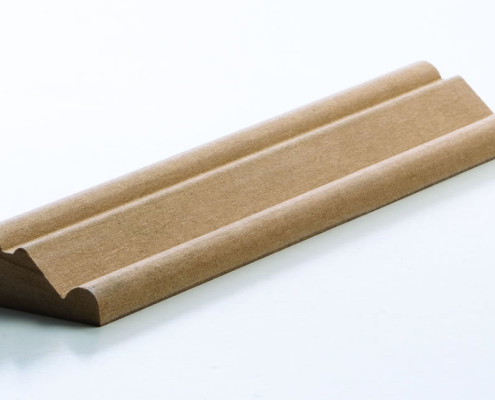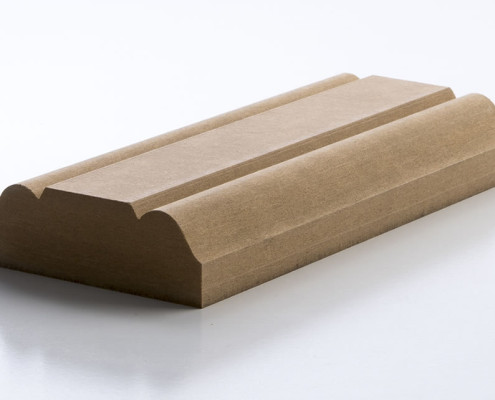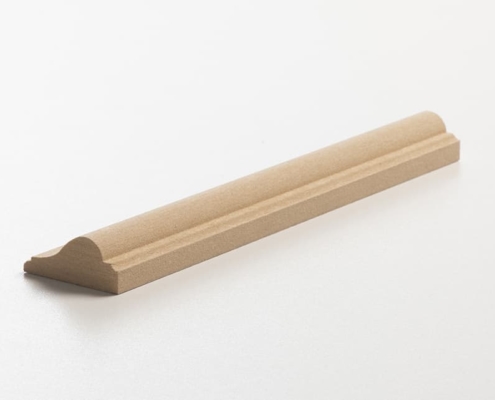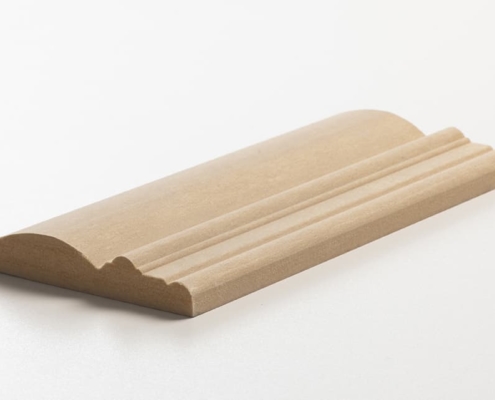Dado Rails / Belt Rails / Wainscoting Rails
Dado Rail Moulding / Belt Rail Moulding / Wainscoting Rail
Moulding
A Dado Rail is more commonly referred to as a Chair Rail. Traditionally installed in period houses as a decorative internal wall feature to establish a proper scale and proportion to a room.
A Dado Rail is a profiled moulding typically fixed horizontally to the wall as an ornate feature or to crown wainscoting wall panelling. Most people associate the Dado rail as a wall trim that aids in protecting the wall from furniture and chairs’ damage.
Classic Architecture rules set the height of the dado rail in relation to the height and proportion of a column pedestal, typically approximately one-fifth the height of the room or 600mm.
Modern Architectural trends set the dado rail height up to 900mm depending on the ceiling height. Hospitals, Aged Care Facilities and Shopping Centres use the dado rail to protect walls in high traffic areas. The height of the dado rail can range from 900mm to 1200mm or even 1500mm and serves as a functional role rather than an aesthetic treatment.
At Colonial Wall Linings we carry a range of Mouldings – Dado Rail Moulding, Chair Rail Moulding, Belt Rail Moulding, Wainscoting Belt Rail Moulding, Bolection Moulding and Picture Rail Moulding.
Picture Rail Moulding
Picture hanging became popular during the Victorian period of the 19th century. The idea of picture hanging dates back to the 15th century. Hanging pictures from moveable hooks that did not mark the wall surface.
Around the 1840s, picture rails or picture moulding became popular with wealthy and middle classes. Showcasing paintings, framed artworks, mirrors and even ornate china plates.
The Picture Rail is a horizontal decorative wood trim most often placed high on the wall below the cornice coving or crown moulding.
During the Victorian era, the picture rails placed at the height of the window and door heads created a decorative band between the picture rail and the ceiling called a frieze. The frieze often received a decorative embellishment.
Picture rail hanging consisted of hooks and picture wire. Modern versions of the picture rail hanging method are prevalent in modern galleries and real estate window display boards.
Whether you’re working on a historical restoration or a modern house with a classic appeal – the picture rail can be a stylish addition. Picture rails appear in hallways, formal sitting rooms, foyers, rooms with wallpaper or unique wall treatments.
Belt Rail Moulding
Queenslanders are a type of dwelling produced in the 1920 and 1930s. Ashgrovian is the term coined for a variation of the Queenslander built in the Brisbane suburb of Ashgrove.
The traditional Queenslander home has very high ceilings ranging from 2700mm to 3200mm. Vertical hardwood VJ Boards line the walls. Internal rooms have finished wall surfaces while the reverse, usually the hallway, has exposed structural timbers.
A structural beam of solid hardwood, 40mm thick to 110mm high called a Belt Rail installed at approximately 1800mm high, helped keep the VJ Wall Boards straight over such heights. A profiled Belt Rail enhances the visual appeal of the otherwise dull structural appearance.
In most modern Queenslander renovations, both sides of the wall are battened and lined with VJ Sheeting; hiding electrical wires, plumbing and wall insulation. Today, a non-structural Belt Rail maintains the traditional look of a Queenslander. The Belt Rail serves the same purpose of the Dado Rail or Chair Rail, providing a visual decoration on the wall to replicate traditional old-world charm.
Bolection Moulding
Bolection is a profiled moulding that first appeared in the latter part of the 17th century, and fashionable French interiors throughout the 18th century — commonly used as a decorative moulding to define ornate and intricately carved wood panelling or Boiserie.
Bolection profiles adorned wall panels, door frames, cupboards and shelves. Mirrors and Paintings were centrally framed by bolection on walls, above the fireplace mantelpiece and even above doorways.
Traditionally, a Bolection Moulding is rebated on the underside, usually hiding the transition between the outer frame and inset panel. The moulding affixed to the upper frame allows floating panels to be held in place while accounting for expansion and contraction with changing temperature and humidity.
Today, Bolection Moulding is used to create decorative wall features and framed panel or Wainscoting panelling. Applied to the lower part of interior walls, Wainscoting is topped with a decorative dado rail, also known as a chair rail.
Wainscoting Belt Rail Moulding
Wainscoting wall panelling became popular during the Victorian period of the 18th and 19th century. With origins dating back to the late 1500s — the term “wainscot” refers to an excellent grade of oak imported for woodwork. By the 17th century, wainscot became a verb, “Wainscoting”, referring to wood panelling applied to a wall.
Developed initially to insulate and make rooms in stone buildings more comfortable, by the 18th century, the style of wood panelling changed from floor-to-ceiling to covering the lower portion of the wall. Traditionally constructed of tongue-and-groove boards, beaded-board or decorative panels. Wainscoting frame and panelling sat above the skirting board crowned with a Wainscoting belt rail (Dado Rail or Chair Rail).
In addition, Wainscoting became a way of protecting walls in high traffic areas; entryways, stairways and hallways. French Boiserie wood panelling, in particular, was very ornate and intricately carved.
Today Wainscoting’s purpose is purely decorative and serves to break the visual wall space. This decorative element can add flair to many decor styles and ultramodern makeovers.
At Colonial Wall Linings, we supply a range of VJ wall sheets, beaded board, Belt Rail, Wainscoting Belt Rail, Dado Rail, Chair Rail and Bolection to create your Wainscoting masterpiece.




